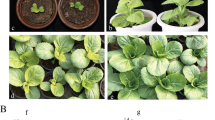Abstract
A chloroplast DNA mutation site associated with the ‘chlorina’ phenotype was identified in mutant lines en:chlorina-7 of Helianthus annuus. Following nitroso-methyl urea (NMU)-retreatment of the en:chlorina-7 mutant maternally inherited revertants in terms of leaf colour and plant vigour were obtained. Thorough restriction analysis revealed rearrangements in revertant (r-en:chlorina) cpDNA. The restoration of the original cpDNA pattern correlated with the correction of chlorophyll deficiency in green revertants.
Similar content being viewed by others
References
Wong-Staal F and Wildman S (1973) Identification of a mutation in chloroplast DNA correlated with formation of defective chloroplasts in variegated mutant of Nicotiana tabacum. Planta 113: 313–326
Schaffiner C, Laasch H and Hagemann R (1995) Detection of a point mutations in chloroplast genes of Antirrhinum majus L. I. Identification of a point mutation in the psaB gene of a photosystem I plastom mutant. Mol Gen Genet 249: 533–544
Hagemann R, Bock R and Hagemann M (1996) Extranuclear inheritance: plastid genetics. Progress in Botany 57: 46–56
Bock R, Kossel H and Maliga P (1994) Introduction of a heterologous editing site into the tobacco plastid genome: the lack of RNA editing leads to a mutant phenotype. The EMBO Journal 13(19): 4623–4628
Johnson E, Schaberlrauch and Sears B (1991) A plastome mutation affects processing of both chloroplast and nuclear DNA-encoded plastid proteins. Mol Gen Genet 225: 106–112
Hagemann R (1982) Induction of plastom mutations by nitroso-urea-compounds. In: Edelman M, Hallick RB and Chua NH (eds) Methods in Chloroplast Molecular Biology, pp 119–127. Amsterdam: Elsevier
Hosticka L and Hanson M (1984) Induction of plastid mutations in tomatoes by nitrosomethylurea. The Journal of Heredity 75: 242–246
Beletski Y, Razoriteleva E and Zhdanov Y (1969) Cytoplasmatic mutations of sunflower induced by N-nitroso-N-methylurea (In Russian). Dokl Ak Nauk SSSR 186: 1425–1426
Beletski Y and Razoriteleva E (1972) Extrachromosomal mutations of sunflower 1. Cytological analysis of variegated plants (In Russian). Genetika 8(1): 17–22
Beletski Y, Fedorenko G, Razoriteleva E and Stepanova L (1981) Reversion in plastom chlorina mutant of sunflower (In Russian). Tsitologia i Genetika 1: 34–38
Turischeva M, Taran S, Beletski Y, Belkina G and Odintsova (1987) Structure and functions of chloroplasts in viable plastome mutants of sunflower (In Russian). Phiziologia rastenii 34-36: 1097–1102
Gustafsson A (1940) The mutation system of the chlorophyll apparatus. Lunds Univ Arsskrift. NF Adv 2 36: 1–40
Hagemann R (1971) Struktur und Funktion der genetischen Information in den Plastiden I. Die Bedeutung von Plastommutanten und die genetische Nomenklatur extranuklearer Mutationen. Biol Zbl 90(4): 409–418
Triboush S, Danilenko N and Davydenko O (1998) A method for isolation of chloroplast DNA and mitochondrial DNA from sunflower. Plant Molecular Biology Reporter 16: 183–189
Razoriteleva E, Beletski Y and Zhdanov Y (1970) The genetically nature of mutations induced by N-nitroso-N-methyl urea in sunflower. II. Themutations chlorina (In Russian). Genetika 6: 102–107
Rochaix J.-D (1997) Chloroplast reverse genetics: new insights into the function of plastid genes. Trends in Plant Science 2(11): 419–425
Richardson F and Richardson K (1990) Sequence-dependent formation of alkyl DNA adducts: A review of methods, results, and biological correlates. Mutation Research 233: 127–138
Serebryanyi A, Sal'nikova L, Bakhitova L and Paschin Y (1990) Role of the carbamoylation reaction in the biological activity of methyl nitrosourea. Mutation Research 231: 195–203
Beranek D (1990) Distribution of methyl and ethyl adducts following alkylation with monofunktional alkylating agents. Mutation Research 231: 11–30
Imai Y (1936) Chlorophyll variegations due to mutable genes and plastids. Z Indukt Abstammungs-und Vererbungslehre 71: 61–83
Kirk J and Tilney-Bassett R (1967) The Plastids. Their Chemistry, Structure, Growth and Inheritance. London and San Francisco: W.H. Freeman and Co.
Samsonova I and Bottcher F (1976) Studies on the mutability of plastom IV. Effect of X-rays, etylmethanesulphonate, ethylene imine and nitrozoethylurethane on the frequency of reverse mutations in the plastom tomato mutant Pl-alb1 (In Russian). Genetika XII(1): 41–46
Spreitzer R, Thow G. and Zhu G (1995) Pseudoreversion substitution at large-subunit residue 54 influences the CO2/O2 specificity of chloroplast ribulose-biphosphate carboxylase/oxygenase. Plant Physiol 109: 681–685
Heyrad F, Serror P, Kuntz M, Steinmetz A and Heizmann P (1987) Physical map and gene localisation on sunflower (Helianthus annuus) chloroplast DNA: evidence for an inversion of a 23.5-kpb segment in the large single copy region. Plant Mol Biol 9: 485–496
Hipkins V, Marshall K, Neale D, Rottmann W and Strauss S (1995) A mutation hotspot in the chloroplast genome of a conifer (Douglas-fir:Pseudotsuga) is caused by variability in the number of direct repeats derived from a partially duplicated tRNA gene. Curr Genet 27: 572–579
Tassopulu D and Kung S (1984) Nicotiana chloroplast genome. 6. Deletion and hotspot - a proposed origin of the inverted repeats. Theor Appl Genet 67: 185–193
Maier R, Neckermann K, Igloi G and Kossel H (1995) Complete sequence of the maize chloroplast genome:gene content, hotspot of divergence and fine tuning of genetic information by transcript editing. J Mol Biol 251(5): 614–628
Chiu W, Johnson E, Kaplan S, Blasko K, Sokalski M, Wolfson R and Sears B (1990) Oenothera chloroplast DNA polymorphism associated with plastome mutator activity. Mol Gen Genet 221: 59–64
Author information
Authors and Affiliations
Corresponding author
Rights and permissions
About this article
Cite this article
Triboush, S.O., Danilenko, N.G., Ulitcheva, I.I. et al. Location of induced mutations and reversions in the chloroplast genome of Helianthus annuus. Plant Growth Regulation 27, 75–81 (1999). https://doi.org/10.1023/A:1006117114857
Issue Date:
DOI: https://doi.org/10.1023/A:1006117114857




